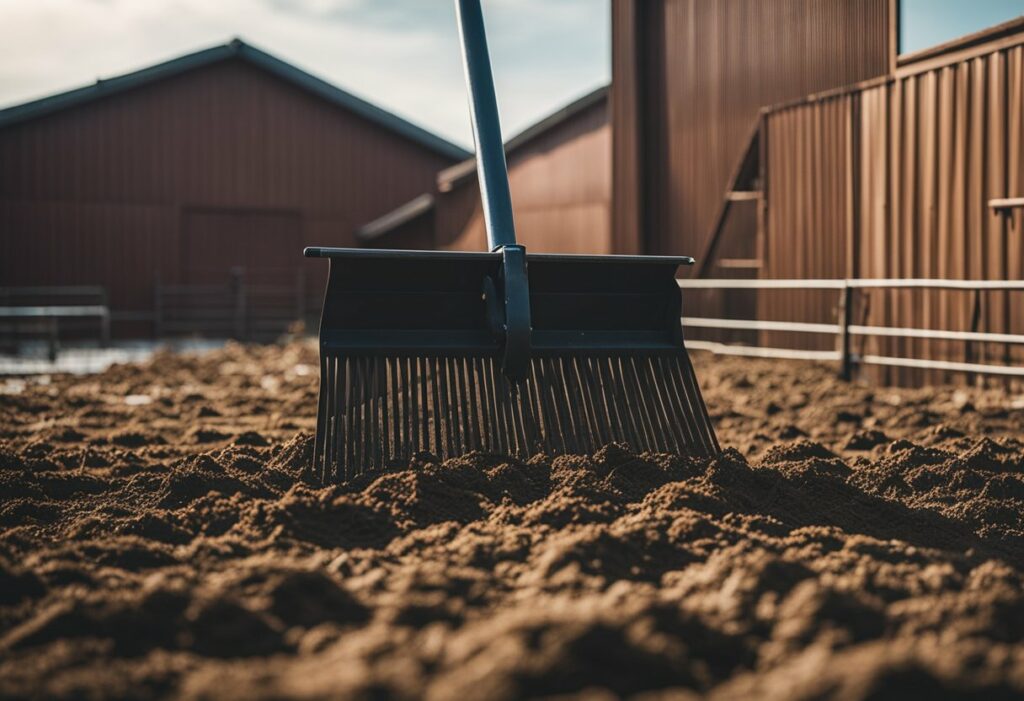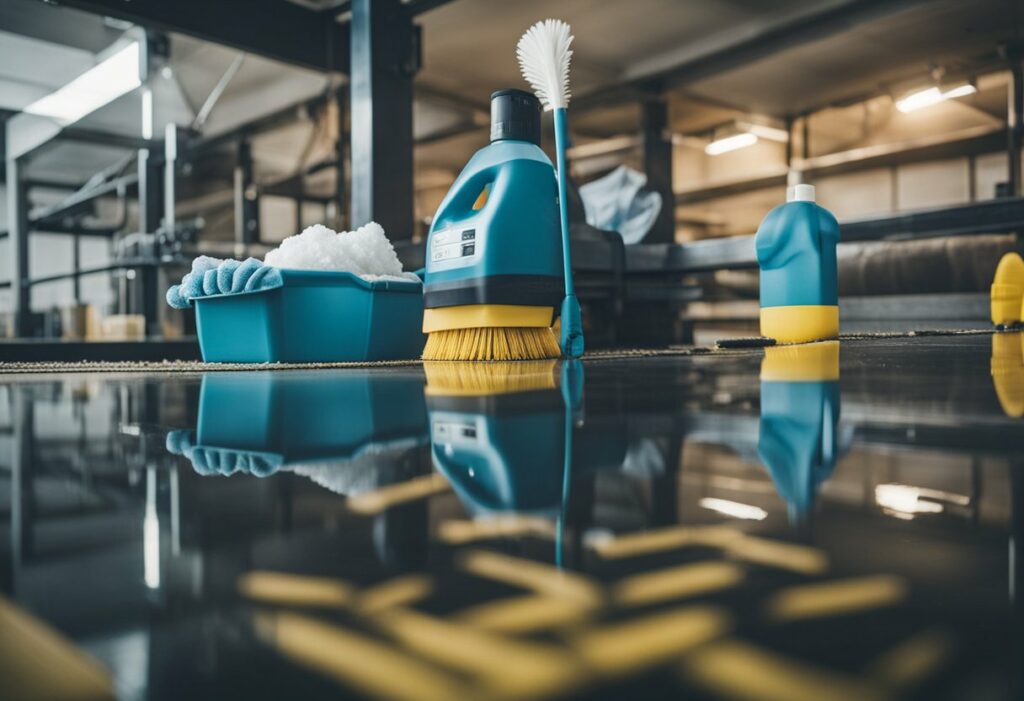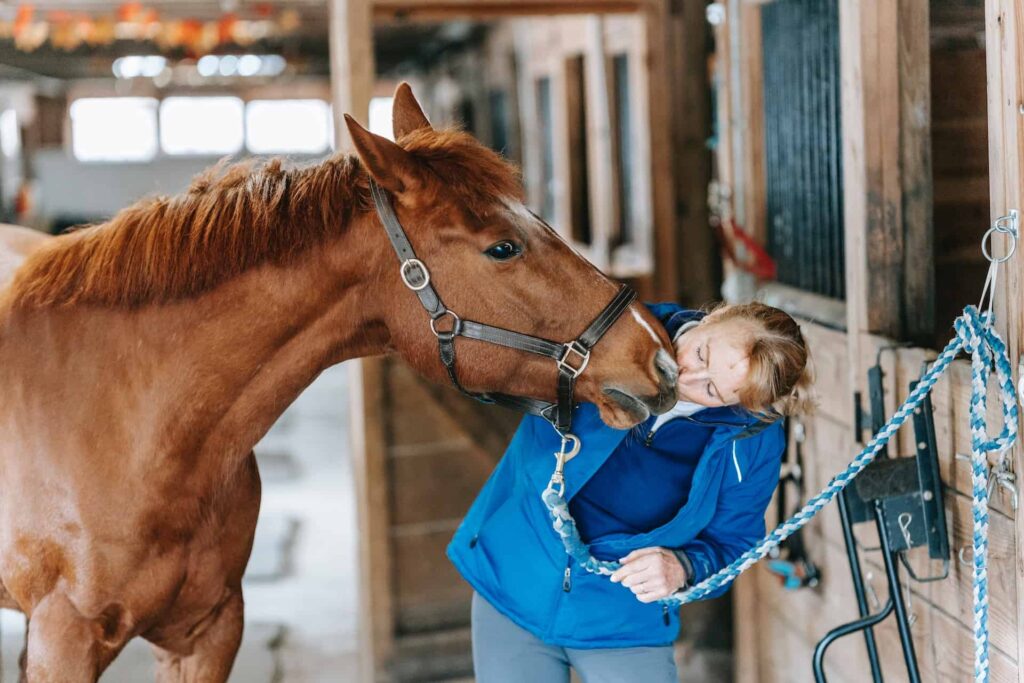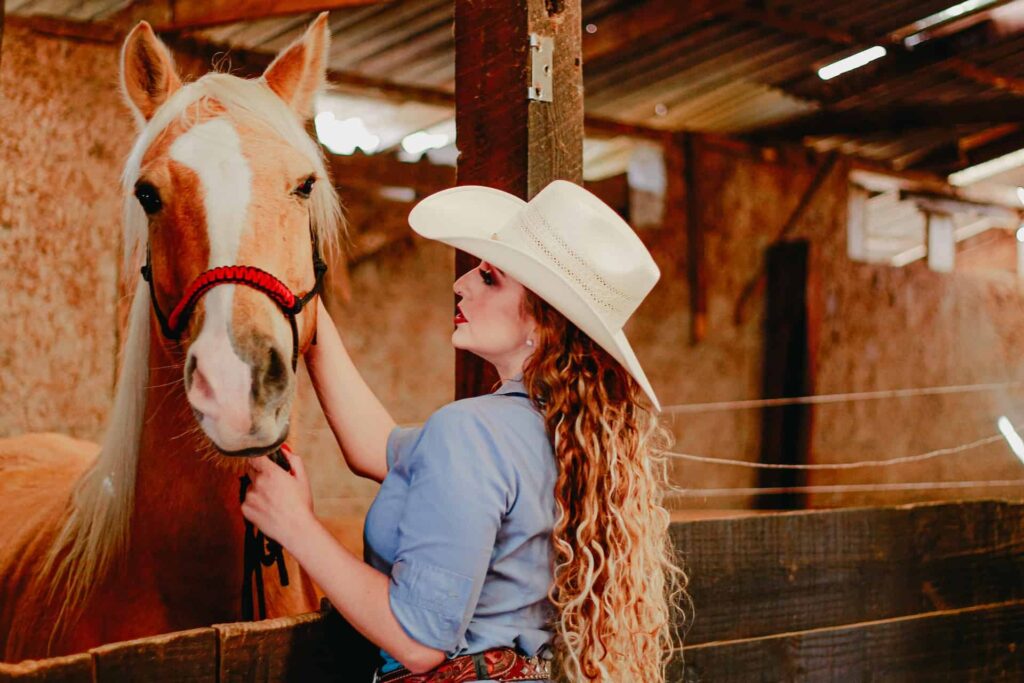Cleaning stables is an important part of horse care, as it ensures a healthy and comfortable environment for the animals. Proper stable cleaning requires attention to various factors, such as the choice of horse bedding materials, the cleaning process, and the disposal of waste, among others. By understanding the basics of stable cleaning and adhering to necessary safety measures, horse owners and caretakers can maintain clean and hygienic conditions in the stables, which in turn positively impacts the well-being of the horses.
There is a range of equipment required for effective and efficient stable cleaning. From various types of tools to the appropriate personal protective gear, being well-equipped is crucial for a thorough cleaning process. Moreover, choosing the right bedding materials for the stables plays a significant role in the overall cleanliness and comfort of the horses’ living environment.
Conducting regular cleaning not only contributes to the horses’ physical health but also aids in preventing the spread of infections and diseases. Proper disposal and management of waste material is a critical component of stable cleaning that ensures a sanitary environment. Ultimately, attending to the cleanliness and maintenance of stables positively affects the overall health and well-being of the horses, and consequently, their performance.
Key Takeaways
- Stable cleaning is crucial for maintaining a healthy environment for horses and involves the right choice of bedding materials and cleaning equipment.
- Following a thorough cleaning process and taking safety measures helps prevent the spread of infections and diseases among horses.
- Proper disposal of waste and regular stable maintenance impact horse health and, subsequently, their performance.
Understanding Stable Cleaning
A well-maintained horse stable aids the health and hygiene of your equestrian friends. Understanding stable cleaning involves various aspects, including cleaning tips, tools, materials, and maintaining a regular schedule.
One of the crucial parts of maintaining a horse stable is knowing the proper daily tasks for stall cleaning. Remove soiled bedding material, manure, and wet spots daily to prevent bacterial growth and ensure a clean environment for the horses. It is crucial to use proper cleaning tools such as manure forks, shovels, brooms, and wheelbarrows. These tools will help make the job more manageable and efficient.
Choosing the right bedding material also plays a significant role in keeping a stable clean. Using materials such as straw, wood shavings, or shredded paper can help absorb moisture and make daily cleanups more straightforward. Replace the bedding frequently to avoid the accumulation of harmful elements in the stable.
When it comes to cleaning a horse stable, it’s necessary to dress for the job. Wear protective clothing, such as gloves, boots, and long-sleeved shirts, to protect yourself from dirt, bacteria, and allergens. This also ensures your own hygiene while maintaining a clean environment for the horses.
Proper organization of tools and materials aids in stable upkeep. Placing storage shelves and hooks near the stable entrance will help you locate necessary items with ease, ultimately improving overall efficiency.
Regular grooming is a vital part of horse hygiene. It helps to monitor the horse’s overall health, detect any potential issues early, and prevent unwanted illnesses. Ensure that you groom your equine friends at least once a day, depending on the horse’s activity level.
Remember that cleaning a stable is a messy job, and staying alert is necessary to ensure your safety as well as the horses’. By maintaining a clean environment for the horses, you will enhance their well-being and comfort.

Equipment Needed for Stable Cleaning
To efficiently clean a stable, specific equipment and materials are necessary. This section will provide an overview of the tools and materials needed for stable cleaning.
A sturdy wheelbarrow is an indispensable tool in any stable. It is used for transporting soiled bedding and manure to disposal areas. Additionally, it can carry fresh bedding and other materials back to the stable. When choosing a wheelbarrow, consider the size, weight, and maneuverability that best suits your stable.
Brooms and shovels are used for sweeping and scooping up debris. A stable broom is ideal for stable floors, while a regular broom can work for smaller spaces and equipment. Shovels come in handy for moving large piles of bedding or manure.
Pitchforks, stall forks, and manure forks are for quick and efficient removal of soiled bedding. Each of these tools has a specific purpose: pitchforks work best with straw bedding, shavings forks are designed for wood shavings, and manure forks help to remove manure from the stable.
Water buckets and buckets are needed for mixing cleaning solutions and carrying water for washing down surfaces. They can also be used to transport unsoiled bedding and other materials.
Protective gear, such as rubber boots, gloves, and appropriate clothing, is critical for maintaining hygiene and safety during the cleaning process. Work gloves protect hands from sharp objects and rough materials, while rubber boots provide waterproof protection and easy cleaning. Leather riding boots are not suitable for stable cleaning as they can be easily damaged and are harder to clean. Appropriate clothing should be comfortable and durable to withstand the demands of stable work.
[it is important to invest in stable equipment to facilitate thorough cleaning and maintain a clean environment for both horses and workers. This includes thick rubber matting or rubber mats that provide a comfortable and easily cleanable surface for horses to rest on.
Lastly, a pressure washer can be a valuable tool for cleaning stable walls, floors, and equipment. It quickly removes dirt, grime, and bacteria, ensuring a properly sanitized environment.
These tools and materials will ensure that stable cleaning is efficient, safe, and thorough.
Choosing the Right Bedding
Types of Bedding
There are various types of bedding materials available for use in stables. Some common options include shavings, sawdust, and straw. Shavings are a popular choice because they are highly absorbent and can help control odors. Sawdust is another option, but it can be dusty and may cause respiratory issues for horses if not managed properly. Straw is a more traditional choice, but it may not be as effective at managing moisture and odor as shavings or sawdust.
When selecting a bedding material, consider factors such as absorbency, dustiness, and cost. Additionally, ensure that the chosen material is readily available and easy to dispose of or compost.
The Importance of Appropriate Bedding
Appropriate bedding is crucial for maintaining a clean and healthy stable environment. Fresh, unsoiled bedding helps reduce the risk of diseases and sicknesses, as it can effectively absorb urine and moisture from wet bedding. It also provides comfort for the horses, helping prevent the development of sores and other health issues.
Deep cleaning of the stable and regularly replacing soiled bedding with clean, fresh bedding is vital for maintaining proper hygiene. A well-managed stable should have a consistent cleaning schedule to remove wet bedding and reduce odors. Using an odor-control solution can also help keep the stable environment sanitary.
By choosing the right bedding material and implementing a consistent cleaning routine, stable owners can provide a comfortable and healthy environment for their horses, minimize the risk of diseases, and maintain overall stable hygiene.
The Cleaning Process
Daily Cleaning
Daily cleaning ensures a clean and healthy environment. Start by using a manure fork or pitchfork to remove manure from the stalls. Focus on removing as much manure and soiled bedding as possible, keeping an eye out for any urine spots. A shavings fork can also be helpful in sifting through the bedding material efficiently.
Next, empty and clean the water buckets using a brush and mild soap solution. Refill the buckets with fresh water, ensuring that the horses always have access to clean water. Sweep the stable floor with a broom or stable broom to remove hay, dust, and debris. Regularly emptying and cleaning feed buckets can also help maintain a sanitary environment in the stable.
Keep the manure pile area neat and tidy, as it prevents the breeding of insects and reduces the spread of diseases. Use a wheelbarrow or shovel to transport the manure to a designated area away from the stable.
Deep Cleaning Stables
Deep cleaning stables should be performed periodically to address any buildup of grime, bacteria, and ammonia. Start by removing all horses and their belongings from the stable, leaving an empty stall for a thorough cleaning.
Begin by mucking out the stalls, using a manure fork or pitchfork to remove all bedding and waste materials. Next, using a broom or pressure washer, clean the walls, ceilings, and floors of the stable to remove any dirt, cobwebs, and debris. If the stable has a bare concrete floor, pay special attention to cleaning the grooves and crevices.
To eliminate ammonia fumes and bacteria effectively, use a stable disinfectant to clean surfaces in the stable. Follow the manufacturer’s instructions, dilute the disinfectant correctly, and apply it using a sprayer, sponge, or mop. Allow the disinfectant to dry completely before reapplying to bed.
Carefully inspect the stable for any signs of insect infestations, such as rodents, flies, or other pests. Make sure to address these issues, taking necessary measures like using insecticides or traps to control and prevent future infestations.
Properly maintaining a clean stable prevents hoof problems and respiratory issues in horses. By following both daily and deep cleaning procedures, you’ll be providing your horses with a comfortable and healthy environment to thrive in.
Dealing with Waste
Cleaning stables effectively involves proper management of waste materials, including manure, wet bedding, urine, and droppings. Maintaining an organized, clean environment is crucial for the health and well-being of horses and other animals housed in the stable.
One aspect of managing waste is designating a specific area for the manure pile. This helps prevent the spread of bacteria and parasites, while also simplifying the process of removal for stable staff. Ensure proper ventilation in the manure storage area to minimize ammonia build-up, which can be harmful to both animals and humans.
The daily routine should include actions to remove manure and wet bedding from stalls. Promptly attending to these tasks reduces the prevalence of disease-causing microorganisms and improves the air quality in the stable. As urine can cause bedding to become damp, it is vital to address this when removing wet bedding. Tools such as pitchforks, shovels, and wheelbarrows may be used to make the process more efficient.
In addition to picking up droppings and removing wet bedding on a daily basis, regular deep cleaning of the stable is necessary. This involves removing all bedding, hosing down the floor, and scrubbing walls and feeders. Allow the stable to air dry before replacing bedding to ensure a clean, dry surface for the animals.
Effective management of waste materials is paramount for maintaining a healthy stable environment. By focusing on properly addressing manure, urine, and damp bedding, stable owners can ensure the well-being of their animals and provide a clean, welcoming space.

Safety Measures in Stable Cleaning
When cleaning stables, prioritize safety for both the individuals involved and the animals. Wearing appropriate clothing such as gloves, rubber boots, and work gloves can reduce the risk of injury or contamination. This attire provides much-needed protection against potential hazards, including insects, flies, spider webs, and cobwebs.
Disinfecting a stable environment can help prevent health issues for the animals. A stable disinfectant should be used to clean surfaces and ensure that pathogens are effectively eliminated. This reduces the chances of hocks and sickness among the horses.
Special attention should be given to the cleaning of doorways, alleys, and other frequently trafficked areas. Removing dirt and debris maintains a safe environment, as these areas can become breeding grounds for insects and bacteria. Bare concrete floors can be made safer by installing thick padding or thick rubber matting. Rubber mats provide cushioning and support, both for the horses and for individuals working in the stable.
Leather riding boots should not be used when cleaning stables since they can become slippery and act as a tripping hazard. Instead, opt for rubber boots that provide better grip and are ideal for working in wet or dusty conditions.
Keeping equipment and tools organized can further contribute to a safe stable environment. Utilizing inexpensive hangers to store items when not in use can help minimize clutter and the risk of accidents. Additionally, maintaining clear alleys and doorways will also help reduce the likelihood of hoof problems and other potential injuries.
Prioritizing safety measures during stable cleaning ensures that both animals and those working in the environment are protected. With the implementation of appropriate attire and equipment, as well as regular cleaning and disinfecting practices, a cleaner and safer stable environment can be maintained.
The Impact of Clean Stables on Horse Health
Maintaining clean stables for any equestrian facility directly impacts horse health. Regular stall cleaning and deep cleaning processes contribute to improved horse hygiene that ultimately prevents diseases, sickness, hoof problems, and hocks.
Stall cleaning involves the removal of urine, manure, and soiled bedding regularly. Accumulated urine can lead to the production of ammonia, a harmful gas that can irritate a horse’s respiratory system, causing health issues. Timely removal of soiled materials and replacement with fresh bedding can inhibit ammonia production, ensuring a safer environment for horses.
Part of maintaining a clean stable is addressing areas directly related to horse hygiene. An equestrian facility should have adequate water supply and drainage to support routine washing and cleaning that helps maintain good horse health. Providing dust and mud-free areas for regular grooming also contributes to better horse hygiene.
Deep cleaning goes beyond daily stall cleaning and involves thoroughly cleaning the entire stable. This process may include disinfecting floors and walls, and addressing any lurking issues that can potentially cause sickness or diseases. Keeping a consistent deep cleaning schedule for stables will minimize the risk of illnesses in horses.
Aside from respiratory issues, maintaining clean stables can prevent hoof and hock problems. Providing appropriate flooring and bedding materials can alleviate horse stress on hooves and hocks, ensuring their well-being. A stable with well-drained flooring can significantly minimize the possibility of developing hoof-related issues such as thrush and abscesses.
A clean stable is indispensable for horse health and should remain a top priority for every equestrian facility. Regular stall cleaning, deep cleaning, and attention to horse hygiene factors are necessary for the well-being of horses, preventing health issues, and diseases, and maintaining better hoof and hock conditions.

Frequently Asked Questions
How often should stables be cleaned?
Stables should be cleaned daily to ensure a healthy environment for the horses. This includes removing soiled bedding and droppings, as well as providing fresh bedding material. Regular cleaning helps prevent the buildup of ammonia, which can cause respiratory issues for both horses and humans. In addition to daily cleaning, a more thorough deep cleaning should be done every few months or as needed. It’s important that the stables stay clean and comfortable for the animals.
What is the best stable cleaning equipment?
Various tools and equipment can be efficient and effective in cleaning a stable. A few important items include manure forks, shovels, brooms, wheelbarrows, and a stable rake. A manure fork helps pick up the soiled bedding and droppings, while shovels and brooms are useful for removing dirt and debris from the floor. Wheelbarrows transport the removed waste, and a stable rake is ideal for spreading fresh bedding material evenly across the stall floor.
Which disinfectant is most effective for horse stables?
There are numerous disinfectants available on the market for cleaning horse stables. One of the widely recommended options is a benzalkonium chloride-based disinfectant. This product is effective against a broad range of bacteria, viruses, and fungi, and has a low toxicity for animals. It’s important to follow the manufacturer’s instructions for dilution and application and to allow the treated surfaces to dry completely before introducing the horses back into the stall.
What are the steps for cleaning stable floors?
- Remove the horses from the stable and place them in a secure area.
- Use a manure fork and shovel to remove soiled bedding, droppings, and debris from the floor.
- Sweep the floor with a broom to remove any remaining dust and dirt.
- Scrub the floor with a cleaner or disinfectant, following the manufacturer’s instructions.
- Rinse the floor thoroughly with water to remove any residue.
- Allow the floor to dry completely before adding fresh bedding material and returning the horses to the stall.
How much do horse stall cleaning services charge?
The cost of horse stall cleaning services can vary depending on factors such as the number of stalls, geographic location, and the frequency of cleaning. Prices may range from $10 to $30 per stall or a monthly fee of $200 to $600 for daily cleaning services. It is advisable to obtain quotes from multiple service providers in your area and to consider factors such as experience and references to ensure a good match for your needs.
What does mucking stalls mean?
Mucking stalls refer to the process of cleaning a horse’s stable to remove waste and soiled bedding materials. This includes scooping up manure and soiled bedding with a manure fork, removing wet or dirty patches, and adding fresh bedding to maintain a healthy living environment for the horse. Performing this task regularly is crucial for keeping your horse’s living space clean, comfortable, and free of harmful bacteria and ammonia buildup.
Last Updated on October 11, 2023 by Nate Dewsbury



